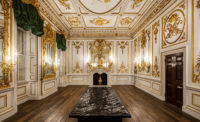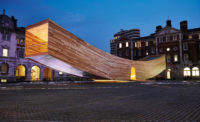London Design Festival Returns for 2023 Edition Focused on Environmental and Social Responsibility

Spirit of Place by Simone Brewster at the 2023 London Design Festival, held September 16–24 at various sites across the city. Photo by Ed Reeve, courtesy LDF
Now in its 21st year, the London Design Festival (LDF) is firmly established as a highlight of the city’s cultural calendar. Held over nine days (September 16-24) and comprising more than 300 events, installations, and exhibitions across 13 “design districts,” it is a sprawling affair offering dizzying profusion and eclectic variety. Some consistency was given to this year’s festival, however, by exhibitors’ shared focus on the biggest ethical questions facing the profession, from cultural sensitivity to social purpose and environmental impact.
The pursuit of new sustainable materials produced much of the most inventive and stimulating work on show. One of LDF’s “landmark” commissions, Spirit of Place by artist and designer Simone Brewster, was a sophisticated advertisement for cork. Cropped from living trees in a regenerative process, the crumbly bark can be bonded with its own natural resins and used to make furniture or construction materials. Five giant cork “vessels” stood on a newly pedestrianized stretch of the Strand in the city center. With the 8-foot-high columns ribbed and grooved like the peeled trunks of cork oaks and brightly painted in reds, oranges, and greens to suggest the surprisingly rich colors found within, the abstract “forest” invited passersby to consider the origins of the material as well as experience its inherent warmth, texture, and strength.

1
.webp)
2
.webp)
3
Staged in conjunction with the London Desgin Festival, the Material Matters fair showcased works by studios including Smile Plastics (1); SCP, Darren Appiagyei, and Goldfinger as part of the Wood Awards exibition (2); and Yair Neuman and Planq (3). Photos courtesy Material Matters
In a dilapidated four-story warehouse on the River Thames, the Material Matters design fair showcased dozens of studios working with compacted hemp fibers, seaweed yarns, bio-leather, and ocean-trawled plastics. Without grandiose claims, these pioneers gave cause for some optimism. Clean-tech start-up The Tyre Collective, for example, sees opportunity in the polluting particles produced by the abrasion of tires on roads—one million metric tons annually in Europe alone. It is developing the first device to capture tire pollution, which can be compacted into pellets and spun into elaborate vases by robot-controlled 3D printers.
-Victoria-and-Albert-Museum-(16).webp)
Part Exchange by Andu Masebo at the Victoria & Albert Museum. Photo courtesy V&A
Urban mining from scrapyards and demolition sites is often touted as the next big thing in material sourcing, reducing the embodied carbon of new products and buildings. LDF exhibitors like Re-Made, a community materials exchange set amid the industrial warehouses of west London, put the idea into practice. Upcycling and creative reuse also offer new expressive possibilities, suggests Andu Masebo, who was awarded the Emerging Designer commission at the Victoria & Albert Museum (V&A), the festival’s main hub. His suite of eight furniture pieces was fashioned from a single Alfa Romeo car at the end of its useful life. On view was a sleek shelving unit formed of cherry-red bodywork and a wine rack made from wheel spokes, each inspired by the histories of former owners. While it lacks the efficiency of mass-production, the painstaking project showed how design might preserve the personal and collective memories invested in things, which are constantly eroded by our throwaway society.

West Kensington studio Goldfinger fabricates furnishings using mature trees removed across London. Photo courtesy Goldfinger
Recycling of materials within the urban economy also helps with localism, and it’s something of a surprise to see how much manufacturing happens in small corners of a city that has lost almost six square miles of industrial land over the last two decades. Furniture-maker Goldfinger operates from the base of a 1970s concrete housing project that looms over West Kensington, and sources its wood from the 5,000 mature trees felled annually in London. At LDF, it showcased softly curvaceous ash tables commissioned for a café at the Tate Modern. Coordinates discreetly etched into the tops identify the location of the trees from which each is made. “That sort of narrative is increasingly what people want from design,” explained Goldfinger’s Carl Blücher.
Many of the richest, most complex narratives woven into exhibits at the 2023 edition of the festival concerned cultural identity and diversity—another recurrent theme. Throughout, there were welcome signs that the established hierarchies and narrow Eurocentrism of relatively recent times are giving way to a more plural and reflective design industry.
Simone Brewster filled the NOW Gallery in Greenwich with a solo show of furniture, jewelry, paintings, and sculptures that married the visual languages of Western Modernism and African art to interrogate perceptions of race, gender, and beauty. Across town, the V&A hosted a beguiling exhibition curated by Deep K Kailey, in which British-born Canadian artist Nirbhai (Nep) Singh Sidhu explored his upbringing in the Sikh religion, and the application of its practices to artistic creation. Vivid, layered tapestries rich in visual symbolism and festooned with golden tassels popped against the crepuscular blue light of the Prince Consort Gallery.
-Singh-Sidhu-and-Without-Shape-Without-Form-(c)-Victoria-and-Albert-Museum-London-(6).webp)
Unstruck Melody by Nirbhai (Nep) Singh Sidhu and Without Shape Without Form at the Victoria & Albert Museum. Photo courtesy V&A
In another V&A installation, the critical gaze was turned on the hidden meanings of the museum’s own collections. Palestinian architect Dima Srouji created exquisite replicas of eight pieces of ancient Middle Eastern glassware originally made for women—tiny and delicate rosewater sprinklers and containers for kohl (used for makeup), painted with copper and speckled with verdigris—which were presented in packing cases, as though the items were ready to return home. The originals had been temporarily removed from their vitrines and replaced with “tomb cards” used to mark archaeological excavations, which detail the often-violent histories that brought them to London.
-Victoria-and-Albert-Museum-London-(2)-copy.webp)
Dima Srouji with her She Still Wears Kohl and Smells Like Roses at the Victoria & Albert Museum. Photo courtesy V&A
The absurdities of design culture also came in for criticism—or light-hearted teasing—in several of the participating design showrooms. At the East London premises of illustrious furniture-maker SCP, the fetishistic tendencies of some design aficionados were acknowledged in a small, curtained area at the back, decorated to resemble a red-walled peep show, containing lamps and stools wearing the fringed skirts of burlesque dancers or equipped with mirrors intended for evidently dubious purposes.
A plethora of pop-up stores, incubators for young talent, and parties in back-street studios lend LDF its celebratory atmosphere, but it is the large-scale commissions that define its public image. This edition featured fewer of the ambitious, building-scaled structures than have appeared in recent years. Instead, there were subtle interventions in public buildings and spaces intended to bring people together.
.webp)
4

5
SCPeep Show curated by Clerkin & Clarke (4); Halo by Studio Waldemeyer at St Stephen Walbrook (5). Photos courtesy SCP (4); Ed Reeve, courtesy LDF (5)
Two of the festival’s landmark public commissions were staged in churches designed by the architect Sir Christopher Wren to mark the 300th anniversary of his death. Below the famous dome of St Paul’s Cathedral, Spanish artist Pablo Valbuena suspended Aura, a slender 65-foot-high column of light whose intensity changed along its length in response to music and song—a potent evocation of collective action. And at St Stephen Walbrook, London-based Studio Waldemayer suspended a pendulum from the dome, whose slow orbit around the central altar enhanced the meditative atmosphere. The full effect was only visible in long-exposure photographs, when a bright, inclined halo appeared to hang in mid-air, formed by a bright light fixture on the twirling cable.

Aura by Pablo Valbuena at St Paul’s Cathedral. Photo by Ed Reeve, courtesy LDF
Both gave a new charge to the architecture and rituals of sacred spaces, but with minimal means and an attractive modesty, calling attention not only to themselves but to what is already there. They seem fitting emblems of a festival that—despite all of the humor, glamor, and buzzy parties—was infused with an earnest sense of responsibility, from which an abundance of useful and beautiful things flowed.


